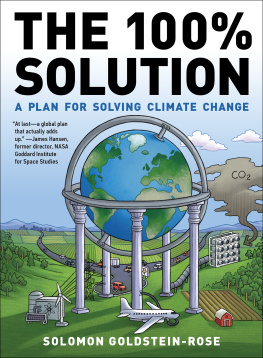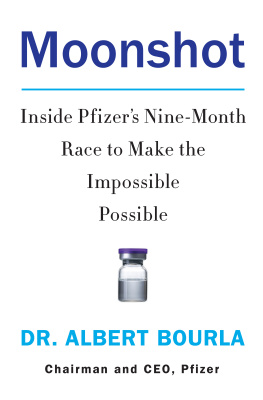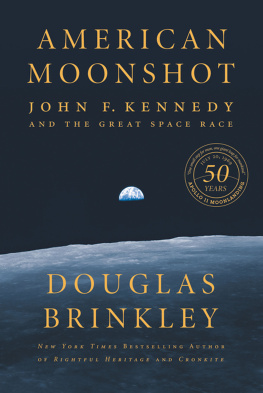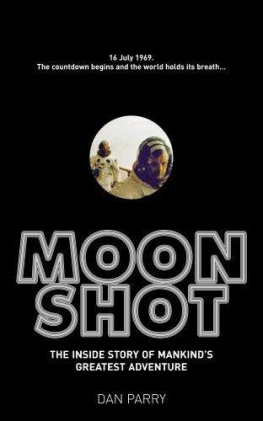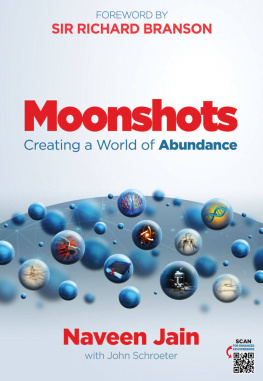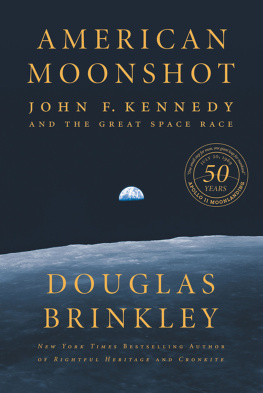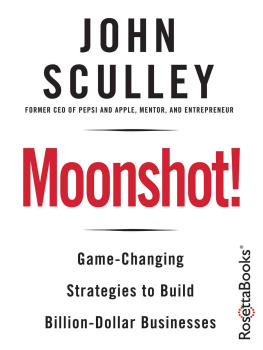THE MOONSHOT EFFECT
Reading The Moonshot Effect will inspire you to push beyond your comfort zone to transform your teams, develop your leaders, and cultivate the heroic in those around you.
LESLIE BLODGETT
Former CEO and Creator of bare Minerals
Goldman and Purmal are extraordinary coaches. They have the ability to consistently uncover new perspectives by breaking through the noise of every-day business.
SCOTT KIM
CEO, Bankrate.com
Bold ideas are great, but success is measured by results. Out-of-this-world coaches Goldman and Purmal deliver the rare blueprint for accomplishing extraordinary outcomes. If youre aiming for the stars, The Moonshot Effect is the book to take you there.
DOUG LEEDS
CEO, IAC Publishing
This is a rare book that will change your assumptions about how innovation happens; it will inspire you to work differently. Goldman and Purmal share their insights into how to achieve something extraordinary. Their wisdom and coaching have repeatedly helped me find unexpected solutions to drive outsized outcomes.
NEIL VOGEL
CEO, About.com
All companies in the marketplace need courageous leaders and innovators who can come up with the next big idea. The Moonshot Effect offers solid advice for breakthrough results.
PAM WALLACK
CEO and President, Davids Bridal
THE MOONSHOT EFFECT: DISRUPTING BUSINESS AS USUAL
Published by

WYNNEFIELD BUSINESS PRESS
Copyright 2016
by Lisa Goldman and Kate Purmal
All rights reserved.
No part of the book may be used or reproduced
in any manner whatsoever without written permission
from the publisher and copyright holders.
Editors: Laurie Gibson, Lisa Wolff, and Steve Almond
Cover design and creative direction: Jenn White Topliff
Book design: Charles McStravick
Print ISBN: 978-0-9729643-1-9
Ebook ISBN: 978-0-9729643-2-6
PRINTED IN THE UNITED STATES OF AMERICA
PREFACE
O ne day I was driving to have breakfast with my business partner Lisa. Lisa is habitually punctualalmost to a fault. So when she texted to say she was going to be five minutes late, it got my attention.
By the time I reached the parking lot, though, I was grateful for the few extra minutes because of a fascinating segment on National Public Radio about the Apollo 11 space program. The segment focused on President John Kennedys decision to send a man to the moon and return him safely to Earth. The mission was issued as a challenge. If the United States could be first to send a man to the moon, Kennedy felt it would re-establish Americas superiority over the Soviet Union during the Cold War.
Kennedy exercised extraordinary leadership, and his approach brilliantly conflated his Presidential persona with the courageous and daring astronauts.
As the segment ended I jumped from my car, worried that Id left Lisa waiting. But instead, she, too, was getting out of her car. We laughedLisa was listening to the same Apollo 11 segment I was and, like me, didnt want to miss a single word.
We put aside our plan to prepare for an upcoming board meeting to talk instead about the Kennedy Moonshot. We discussed the impact of the moonshot on the country and on our own lives. We deconstructed what made the Apollo space initiative and President Kennedys leadership so effective and compelling. We realized that Kennedys challenge to go where no human had gone before was not just about going to the moon; it was about harnessing human aspiration to accomplish something extraordinary, something that seemed nearly impossible to achieve.
The Moonshot.
We discussed the implications and drew parallels to our experiences in business, because thats what we do. We work with executives to achieve greater impact and inspire excellence in the people who make up the heart of their business.
We defined a moonshot as a complex, large-scale objective that can be accomplished only when teams abandon business as usual.
Moonshots require significant breakthroughs in attitude, innovation, leadership, processes, management, and technology. They demand extraordinary execution and are often marked by seemingly unrealistic time lines.
Most moonshots are driven by a desire to be the first, or the best, or the fastest. They disrupt the status quo.
Lisa and I counted the business moonshots we had been involved withindividually and together. Eighteen. This number blew us away. Most people, if they are lucky, get to participate in one or two during their careers. It seems that Lisa and I have a knack for instigating impossible projects.
My first real moonshot was in the 1990s with the creation of the PalmPilotthe precursor to the smartphone. Lisas most memorable moonshot was Nokias MOSH, the first big mobile social sharing platform, which swelled to 13 million users in its debut year. It was our realization of our extensive experience with moonshots that planted the seeds for this book.
Later, as we interviewed colleagues and clients who had led and taken part in moonshots, we discovered something unexpected.
Most of the people we interviewed had forgotten a whole host of business impacts they had created via the moonshot. They had forgotten that their moonshot resulted in making the Inc. list of most innovative companies, and the millions of dollars of revenue they generated. They had forgotten about shareholder value, return on investment, and profit margins.
Instead, they remembered the near-miracles they accomplished through the sheer force of teamwork, determination, and dogged execution. They told us about careers that had been catapulted into the stratosphere. They reminded us of the everyday employees who had become superstars by making heroic contributions. They revealed the behind-the-scenes camaraderie, passion, and pride people felt because they were involved in something remarkable.
The interviews led us to a fundamental conclusion about moonshots: while they create extraordinary business impact, the magic of a moonshot is the profound impact on the people who create them. Moonshots are an act of human courage, imagination, and determinationwrit large. When a business summons those qualities in its people, both the employees and the company are transformed.
Moonshots elevate contribution and challenge people to perform beyond what they think possible. In Lisas work alone, more than half of the executives who ran the moonshot projects were promoted to CEO within two years. Moonshots also create strong bonds of loyalty and friendship. Lisa and I are proof of that.
Our hope in writing this book is that we will inspire you to summon the courage and resources to champion and participate in a moonshot. Because each time you are involved in a moonshot, you harness the best of your energies and skills, and experience the exhilaration that comes when you escape business as usual.
LISA GOLDMAN & KATE PURMAL
INTRODUCTION
W hen John F. Kennedy took office as the 35th president of the United States in 1961, America was locked in geopolitical crisis. Communism was taking hold in North Korea. In Cuba, Castros alliance with the Soviet Union brought the potential for Soviet missiles closer to home. With the launch of the Sputnik satellite in 1957, the Soviets claimed an early lead in the space race as a Communist triumph.
Missiles were the measure of military might in the Atomic Age, and airspace the unclaimed military frontier. The nuclear threat was deeply ingrained in the American psyche, as schoolchildren practiced crouching under their desks in case of missile attacks. The threat was real.




